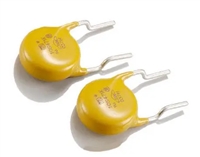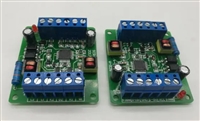ICS251 DATASHEET
PCB Layout Recommendations
IDT VersaClock Software
For optimum device performance and lowest output phase
noise, the following guidelines should be observed.
IDT applies years of PLL optimization experience into a user
friendly software that accepts the user’s target reference clock
and output frequencies and generates the lowest jitter, lowest
power configuration, with only a press of a button. The user
does not need to have prior PLL experience or determine the
optimal VCO frequency to support multiple output
frequencies.
1) The 0.01µF decoupling capacitor should be mounted on the
component side of the board as close to the VDD pin as
possible. No vias should be used between the decoupling
capacitor and VDD pin. The PCB trace to VDD pin should be
kept as short as possible, as should the PCB trace to the
ground via. Distance of the ferrite bead and bulk decoupling
from the device is less critical.
VersaClock software quickly evaluates accessible VCO
frequencies with available output divide values and provides
an easy to understand, bar code rating for the target output
frequencies. The user may evaluate output accuracy,
performance trade-off scenarios in seconds.
2) The external crystal should be mounted just next to the
device with short traces. The X1 and X2 traces should not be
routed next to each other with minimum spaces, instead they
should be separated and away from other traces.
Spread Spectrum Modulation
The ICS251 utilizes frequency modulation (FM) to distribute
energy over a range of frequencies. By modulating the output
clock frequencies, the device effectively lowers energy across
a broader range of frequencies; thus, lowering a system’s
electro-magnetic interference (EMI). The modulation rate is
the time from transitioning from a minimum frequency to a
maximum frequency and then back to the minimum.
3) To minimize EMI, the 33 series termination resistor (if
needed) should be placed close to the clock output.
4) An optimum layout is one with all components on the same
side of the board, minimizing vias through other signal layers.
Other signal traces should be routed away from the ICS251.
This includes signal traces just underneath the device, or on
layers adjacent to the ground plane layer used by the device.
Spread Spectrum Modulation can be applied as either “center
spread” or “down spread”. During center spread modulation,
the deviation from the target frequency is equal in the positive
and negative directions. The effective average frequency is
equal to the target frequency. In applications where the clock
is driving a component with a maximum frequency rating,
down spread should be applied. In this case, the maximum
frequency, including modulation, is the target frequency. The
effective average frequency is less than the target frequency.
ICS251 Configuration Capabilities
The architecture of the ICS251 allows the user to easily
configure the device to a wide range of output frequencies, for
a given input reference frequency.
The frequency multiplier PLL provides a high degree of
precision. The M/N values (the multiplier/divide values
available to generate the target VCO frequency) can be set
within the range of M = 1 to 2048 and N = 1 to 1024.
The ICS251 operates in both center spread and down spread
modes. For center spread, the frequency can be modulated
between +/- 0.125% to +/-2.0%. For down spread, the
frequency can be modulated between -0.25% to -4.0%.
The ICS251 also provides separate output divide values, from
2 through 20, to allow the two output clock banks to support
widely differing frequency values from the same PLL.
Both output frequency banks will utilize identical spread
spectrum percentage deviations and modulation rates, if a
common VCO frequency can be identified.
Each output frequency can be represented
as:
Spread Spectrum Modulation Rate
REFFreq
M
N
-------------------------------------- ----
OutputFreq = OutputDivide
The spread spectrum modulation frequency applied to the
output clock frequency may occur at a variety of rates. For
applications requiring the driving of “down-circuit” PLLs, Zero
Delay Buffers, or those adhering to PCI standards, the spread
spectrum modulation rate should be set to 30-33 kHz. For
other applications, a 120 kHz modulation option is available.
Output Drive Control
The ICS251 has two output drive settings. Low drive should
be selected when outputs are less than 100 MHz. High drive
should be selected when outputs are greater than 100 MHz.
(Consult the AC Electrical Characteristics for output rise and
fall times for each drive option.)
REVISION E 05/19/14
3
FIELD PROGRAMMABLE SS VERSACLOCK SYNTHESIZER






 AD637数据手册解读:主要特性、引脚及其功能解读、电气参数
AD637数据手册解读:主要特性、引脚及其功能解读、电气参数

 ADUM1201资料手册解读:参数分析、引脚说明、应用分析
ADUM1201资料手册解读:参数分析、引脚说明、应用分析

 一文带你了解压敏电阻器在直流电路中的过压保护作用
一文带你了解压敏电阻器在直流电路中的过压保护作用

 可控硅触发板选型指南
可控硅触发板选型指南
